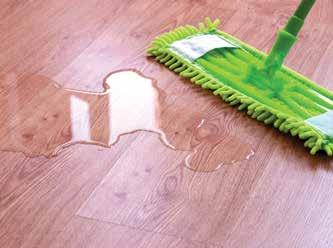
4 minute read
Resilient Floor Care and Maintenance
One of the most popular features of resilient flooring is that it’s so easy to clean. It’s moisture resistant and doesn’t trap dirt and dust the way other surfaces do. It’s also naturally stain resistant — spills just wipe away. But, since we haven’t developed a self-cleaning product yet, we’ve got some general maintenance tips to help keep your flooring looking great!
Residential Luxury Flooring
Advertisement
The initial cleaning for floating floors can start right after the installation whereas if the LVT is installed with an adhesive, a 48 hour waiting period is required. This period is required to allow the adhesive to sufficiently dry before washing the floor with water and a cleaning solution. An important part of the maintenance protocol is to prevent potential problems that can damage your floor.
● Prevent indentations and scratches, use glass, polished metal or non-staining cups or casters with flat under surfaces. The diameter furniture protector must be large enough to distribute the load properly. ● Use walk-off mats to remove imbedded grit from your shoes. Avoid the use of rubber or latex backed ● Avoid high heels on your floor. They can cause permanent damage. ● Spills — any spills should be cleaned up immediately. The longer the stain is allowed to remain on the floor the greater the risk of permanently staining the floor. Refer to the detailed
Consumer Protection Plan. ● When moving frequently moved furniture be sure to protect the floor from damage by using plywood or other hard surface. ● Avoid to direct sunlight for prolonged periods, this can result in discoloration. Excessive high temperatures can cause expansion. During peak sunlight hours it is recommended that drapes or blinds be used to protect the floor from direct sunlight
Residential and Light Commercial
● Daily sweeping and vacuuming will prevent dirt and grit particles from being ground into the surface. ● Light daily washing. ● The frequency and amount of traffic will determine the need and frequency of maintenance. ● After the initial cleaning it may be necessary to use a pH neutral cleaner. When using a cleaner it will necessary to remove the residual film, frequently change the rinse water.
Remove the water quickly with a wet/dry pick up vacuum, any resulting film left on the floor can leave the surface dull, cloudy appearance.
This cloudy film must be removed with clean rinse water. ● If the surface becomes dull or scratched it may be necessary to apply a good floor polish; check with manufacturer’s recommendations for the polish to use to restore the floor’s surface to its original level of gloss. Before applying the polish be certain to thoroughly clean the floors to remove all of the existing dirt. ● When applying floor polish be certain to follow the application and use instructions. ● In time, it will be necessary to remove old coating. Use a high quality floor polish remover.
Follow the detailed manufacturing instructions.
● Spray-Buffing is an effective method of commercial maintenance and can be used on the
LVT for light commercial applications.
Commercial LVT and Sheet Vinyl
A commercial jobsite will accumulate significant amounts dirt and grit. The initial cleaning must not be performed for a minimum of 72 hours. Floor maintenance prevention and protection is extremely important. It will be necessary to sweep and vacuum the floor to prevent premature damage. ● Sweep or vacuum to remove all of the loose dirt and grit. ● Prepare a cleaning solution a recommended. pH neutral cleaner. Refer to the individual maintenance instructions. ● Follow the dilution ratio provided on the cleaning solution instructions. ● Apply the solution using a nylon
or rayon mop
● Dwell time of the solution is important, the time is determined by soil conditions. Do not allow the solution to dry. ● Scrub the floor using a single disc rotary machine, 175–350 rpm equipped with a red pad. ● Use a wet/dry vacuum to remove cleaning solution. ● Rinse thoroughly. ● Repeat if necessary.
Preventive Care
Use effective walk-off mats at entrances and exits. ● Use protective good quality casters or glides under static and dynamic appliance, furniture, etc. ● Do not use harsh cleaning solutions or excessively abrasive cleaning pads. ● Do not use compounds or mops containing or treated with petroleum-based products. ● Do not use cleaning solution that contain aromatic solvents. ● Do not use oil or solvent based products on or near the flooring, they can cause the reduction of the COF or discolor the surface. ■
Deep Cleaning may be necessary, it’s dependent on the type and amount of traffic
● Remove dirt and grit by sweeping or vacuuming. ● Use a good quality pH neutral cleaner, refer to the detailed instructions. ● Follow the manufacturer’s instruction for the appropriate dilution ratio. ● Use a nylon or rayon mop to apply the cleaning solution. ● Dwell time of the solution is important, the time is deter-mined by soil conditions. Do not allow the solution to dry. ● Scrub the floor using a single disc rotary machine, 175–350 rpm equipped with a red pad. ● Use a wet/dry vacuum to remove cleaning solution. ● Rinse thoroughly. ● Repeat the cleaning process if necessary.










